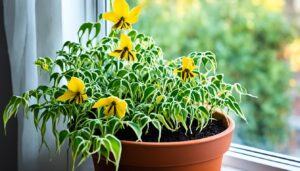Introduction:
In the realm of indoor foliage, few plants possess the delicate allure and tropical elegance quite like the Butterfly Palm, scientifically known as Dypsis lutescens or more commonly referred to as the Areca Palm. With its gracefully arching fronds and slender stems, this botanical beauty not only adds a touch of lush greenery to any space but also serves as a natural air purifier, making it a cherished companion for both novice and seasoned plant enthusiasts alike.
Caring for a Butterfly Palm is akin to nurturing a piece of paradise within the confines of your home or office. From providing the right balance of sunlight to maintaining optimal moisture levels, every aspect of its care contributes to its flourishing growth and vibrant presence. In this comprehensive guide, we delve into the essential tips and techniques for cultivating a thriving haven for your Butterfly Palm, ensuring it thrives with fluttering grace for years to come.
Light and Temperature Requirements
Proper lighting and temperature conditions are paramount for the health and vitality of your Butterfly Palm. Understanding and meeting these requirements will ensure optimal growth and prevent common issues such as yellowing leaves or stunted growth.
- Light: Butterfly Palms thrive in bright, indirect sunlight. While they can tolerate some direct sunlight, prolonged exposure to harsh rays can scorch their delicate fronds. Ideally, place your plant near a north or east-facing window where it can receive ample but filtered sunlight throughout the day. If direct sunlight is unavoidable, consider using sheer curtains or blinds to diffuse the light and protect the plant.
Light Requirements Summary:
Light Level | Description |
Bright Indirect | Ideal for healthy growth, avoid direct sun |
Moderate Indirect | Tolerable, but monitor for signs of stress |
Low Indirect | Insufficient for optimal growth |
- Temperature: Butterfly Palms thrive in warm, tropical environments reminiscent of their native habitat. Aim to maintain temperatures between 65°F to 80°F (18°C to 27°C) during the day and avoid drastic fluctuations. While they can tolerate slightly cooler temperatures at night, it’s essential to protect them from drafts and cold air, which can lead to stress and susceptibility to pests or diseases.
Temperature Guidelines:
- Daytime: 65°F to 80°F (18°C to 27°C)
- Nighttime: Above 55°F (13°C)
- Avoid sudden temperature drops or drafts
Watering and Humidity Needs
Proper watering and humidity levels are crucial aspects of Butterfly Palm care. Maintaining a consistent watering schedule and providing adequate humidity will help prevent issues such as root rot and dry, crispy leaves, ensuring your palm remains vibrant and healthy.
- Watering: Butterfly Palms prefer consistently moist soil but are susceptible to root rot if overwatered. A good rule of thumb is to water your palm when the top inch of soil feels dry to the touch. Ensure thorough watering, allowing water to penetrate the entire root ball, but avoid letting the plant sit in standing water, as this can lead to waterlogged soil and root suffocation.
Watering Guidelines:
- Frequency: Every 1-2 weeks, depending on environmental conditions
- Amount: Water until excess moisture drains from the bottom of the pot
- Adjustments: Reduce watering during the winter months when growth slows
- Humidity: Originating from tropical regions, Butterfly Palms thrive in high humidity environments. Indoors, especially during the winter months when indoor heating can dry out the air, it’s essential to provide supplemental humidity to mimic their natural habitat. You can increase humidity levels by placing a humidifier near the plant, grouping plants together to create a microclimate, or using pebble trays filled with water beneath the pot.
Humidity Recommendations:
- Ideal Range: 50% to 60% humidity
- Supplemental Methods: Humidifiers, pebble trays, misting
Signs of Low Humidity:
- Browning leaf tips
- Dry, crispy leaves
- Stunted growth
Soil and Fertilization
Choosing the right soil and providing appropriate fertilization are essential components of Butterfly Palm care. The proper soil composition ensures adequate drainage and nutrient availability, while regular fertilization provides the necessary nutrients for healthy growth and vibrant foliage.
- Soil Composition: Butterfly Palms thrive in well-draining, fertile soil that retains moisture without becoming waterlogged. A high-quality potting mix designed for palms or tropical plants is ideal. These mixes typically contain a combination of peat moss, perlite, and coarse sand to promote drainage while retaining moisture. Avoid heavy soils that compact easily, as they can suffocate the plant’s roots and lead to waterlogged conditions.
Recommended Soil Mix:
- Peat moss
- Perlite
- Coarse sand
- Organic matter (e.g., compost)
Soil Characteristics:
Soil Attribute | Description |
Drainage | Rapid drainage to prevent waterlogging |
Moisture Retention | Retains moisture without becoming soggy |
Aeration | Allows air circulation around roots |
Nutrient Availability | Provides essential nutrients for plant growth |
- Fertilization: Butterfly Palms benefit from regular fertilization during the growing season to support their lush foliage and overall health. A balanced, water-soluble fertilizer formulated specifically for palms or tropical plants is recommended. Apply fertilizer every 4-6 weeks during the spring and summer months, following the manufacturer’s instructions for dilution and application rates.
Fertilizer Recommendations:
- Balanced, water-soluble fertilizer (e.g., 20-20-20)
- Apply every 4-6 weeks during the growing season
- Dilute according to package instructions
Signs of Nutrient Deficiency:
- Yellowing or pale leaves
- Stunted growth
- Reduced leaf production
Repotting and Pruning
Regular repotting and occasional pruning are important aspects of Butterfly Palm care to promote healthy growth, prevent root bound conditions, and maintain an attractive appearance. Understanding when and how to repot and prune your palm will contribute to its longevity and vitality.
- Repotting: Butterfly Palms typically require repotting every 2-3 years, or when they outgrow their current container. Signs that indicate your palm may need repotting include roots emerging from the drainage holes, soil drying out quickly after watering, or the plant becoming top-heavy and unstable. Choose a pot that is 1-2 inches larger in diameter than the current one and has adequate drainage holes.
Steps for Repotting:
- Select a new pot with drainage holes.
- Prepare fresh potting mix.
- Gently remove the palm from its current pot.
- Loosen and trim any circling roots.
- Place the palm in the new pot and fill with soil.
- Water thoroughly and allow excess water to drain.
Repotting Frequency:
- Every 2-3 years or as needed
- Spring or early summer is the best time for repotting
Indications for Repotting:
- Roots protruding from drainage holes
- Soil drying out quickly
- Plant becoming top-heavy
- Pruning: Pruning helps maintain the Butterfly Palm’s attractive appearance by removing dead or yellowing fronds and promoting new growth. Use clean, sharp pruning shears to make cuts at a 45-degree angle just above the base of the frond. Avoid cutting into the main stem or removing more than one-third of the plant’s foliage at a time to prevent stress.
Pruning Guidelines:
- Remove dead or yellowing fronds as needed.
- Prune damaged or diseased foliage promptly.
- Avoid over-pruning to maintain the palm’s natural shape.
Benefits of Pruning:
- Stimulates new growth
- Improves air circulation
- Enhances aesthetic appeal
Conclusion: Cultivating Grace and Greenery
In the pursuit of nurturing a thriving indoor oasis, the care and cultivation of a Butterfly Palm stand as a testament to the rewarding journey of botanical stewardship. As we’ve journeyed through the essential aspects of Butterfly Palm care – from providing the right balance of light and temperature to ensuring proper watering, soil composition, and occasional repotting and pruning – we’ve uncovered the delicate dance of harmony between human caretaker and botanical companion.
The allure of the Butterfly Palm lies not only in its graceful fronds and tropical charm but also in the symbiotic relationship it fosters within its environment. As we attentively tend to its needs, we are rewarded not only with verdant foliage but also with a sense of tranquility and connection to nature’s rhythms.
In the grand tapestry of indoor gardening, the Butterfly Palm emerges as a beacon of resilience and beauty, reminding us of the profound impact a single plant can have on our well-being and surroundings. Whether adorning a living room corner, office space, or botanical sanctuary, this botanical gem serves as a constant reminder of the transformative power of nature’s embrace.
So, as we bid adieu to this exploration of Butterfly Palm care, let us carry forward the lessons learned – the importance of patience, attentiveness, and respect for the natural world – as we continue to cultivate grace and greenery in our lives, one frond at a time.
If you happen to be in our neck of the woods, stop in and say Hi. We are at The Landscape Connection in Rockford Illinois




Pingback: Areca Palm, The Elegant, Pet-Safe Palm That Purifies Indoor Air